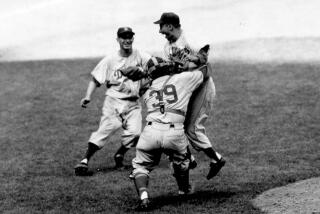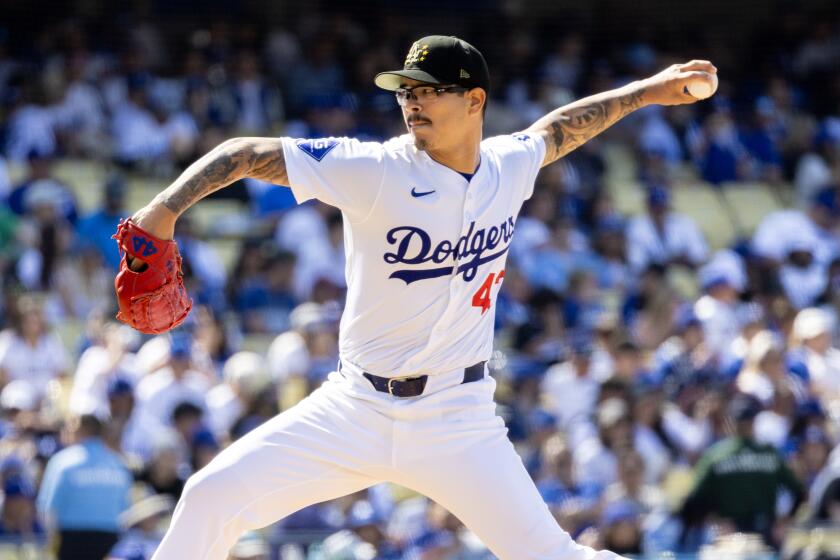DIAMOND JUBILEE
1 Gibsonâs home run
Oct. 15, 1988
--
The most dramatic moment in the history of the ballpark might also be the most memorable moment in Los Angeles sports history.
The Dodgers were down to their final out, trailing the heavily favored Oakland Athletics by a run in Game 1 of the World Series, when manager Tom Lasorda summoned a sick and injured Kirk Gibson to face American League saves leader Dennis Eckersley.
Gibson had injuries to both legs and was bothered by a stomach virus, but he hobbled to the plate after Mike Davis had worked a two-out walk.
After falling behind 0-2, Gibson worked the count full. Then, remembering scout Mel Didierâs observation that Eckersley liked to throw backdoor sliders to left-handed hitters in such situations, Gibson muscled a 3-2 pitch into the right-field pavilion.
As Gibson limped around the bases, pumping his fist, Hall of Fame broadcaster Vin Scully famously said, âIn the year that has been so improbable, the impossible has happened.â
The Dodgers won the game, 5-4, and the series, 4-1. It was Gibsonâs only at-bat in the Series.
The Dodgers havenât won a World Series since.
2 Koufaxâs perfect game
Sept. 9, 1965
--
Sandy Koufax hadnât won a game in three weeks when he went out and threw the only perfect game in Dodgers history.
Through seven innings, neither the Dodgers nor Chicago Cubs had a hit as Koufax was locked in a duel with Bob Hendley, who had only recently been promoted from the minor leagues.
The only run of the game was unearned, scored by the Dodgers in the fifth inning after Lou Johnson drew a walk and advanced to second base on a sacrifice bunt by Ron Fairly. Johnson stole third, which resulted in an errant throw by Cubs catcher Chris Krug that allowed Johnson to score.
Koufax struck out 14 and finished the game with a flourish, striking out the last six batters he faced. Harvey Kuenn, who made the final out in Koufaxâs 1963 no-hitter, made the final out.
There were only two baserunners in the game -- still a record.
Koufaxâs performance was voted the greatest pitched game of all time in a 1995 poll of members of the Society for American Baseball Research. It was his fourth no-hitter, breaking Bob Fellerâs previous record of three.
3 Fernandomania begins
April 9, 1981
--
The phenomenon started on opening day when Fernando Valenzuela, a pudgy 20-year-old rookie left-hander from Mexico, drew the starting assignment because veterans Jerry Reuss and Burt Hooton were injured.
Valenzuela responded by shutting out the Houston Astros, 2-0, the beginning of a season in which he would become the only player in major league history to win the rookie-of-the-year and Cy Young awards in the same year. The Dodgers also won the World Series.
Valenzuela started the season 8-0 with an 0.50 earned-run average, and demand for his time was such that he had to conduct news conferences in every city the Dodgers visited.
His best pitch: a screwball that ran away from right-handed hitters.
His signature move: looking skyward at the height of his windup.
His legacy: Dodger Stadium became a melting pot. About 40% of the teamâs fan base is now Latino, according research conducted by the Dodgers.
4 Game 4, 1963 World Series
Oct. 6, 1963
--
Of the four World Series championships the Dodgers have won since coming to Los Angeles, this was the only time they clinched at Dodger Stadium.
The winning pitcher was Koufax, who coaxed New York Yankees outfielder Hector Lopez to ground out for the final out of the sweep-sealing 2-1 victory. It was Koufaxâs second complete game of the series, and he was chosen the World Series MVP.
The Dodgers went ahead, 1-0, on a fifth-inning home run by Frank Howard, but the Yankees tied the score in the seventh on a Mickey Mantle blast. In the bottom of the seventh, Jim Gilliam hit what appeared to be a harmless grounder to third base, but Yankees first baseman Joe Pepitone lost Clete Boyerâs throw because he couldnât distinguish the ball from the white shirts in the stands. Gilliam advanced to third and scored on a sacrifice fly by Willie Davis.
5 Debut of Dodger Stadium
April 10, 1962
--
Times columnist John Hall wrote, from opening day of the 1962 season: âLos Angeles has itself a major league ballpark, a truly remarkable stadium that is obviously destined to become recognized as the finest in the world. And those who were there will never forget how it all started. . . .â
Owner Walter OâMalleyâs wife, Kay, threw out the ceremonial first pitch. The first real pitch was made by Johnny Podres, the Dodgersâ 1955 World Series hero. Eddie Kasko of the Cincinnati Reds doubled to lead off the game. The Dodgersâ first hit was a single by Hall of Fame outfielder Duke Snider leading off the second inning. The Dodgers lost, 6-3.
The promise of a new ballpark persuaded OâMalley to move the team to Los Angeles before the 1958 season after his efforts to build in Brooklyn failed. The construction of Dodger Stadium didnât come without controversy. The land on which the stadium sits was purchased by the city using eminent domain and some residents of what used to be a Mexican American community were forced out of their homes.
6 Monday saves the flag
April 25, 1976
--
In 1965, Rick Monday was the first player selected in baseballâs first amateur draft, and he became a two-time All-Star. He has been a Dodgers broadcaster for the last 18 years. But Monday is best known for preventing an American flag from being burned in the Dodger Stadium outfield.
A center fielder for the Chicago Cubs at the time, Monday watched as a couple of protesters unfolded a flag in shallow left field and doused it with lighter fluid. When Monday realized what was happening, he ran over. One of the protesters lighted a match, but the wind blew it out. Right as a second match was being lighted, Monday snatched away the flag.
The fans in the stadium broke into an impromptu rendition of âGod Bless America.â When Monday approached the plate for his at-bat the following inning, the scoreboard flashed the message, âRICK MONDAY . . . YOU MADE A GREAT PLAY.â The Dodgers acquired Monday, a former Marine Corps reservist, at the end of the season.
7 Pope visits
Sept. 16, 1987
--
The largest crowd ever to assemble inside Dodger Stadium -- more than 63,000 -- didnât come to watch Koufax or Valenzuela or a World Series game. It came to see and listen to Pope John Paul II. He didnât disappoint them as he presided over Mass, delivering his sermon in both English and Spanish. The event started with the largest-ever gathering of U.S. bishops entering the stadium.
A sky writer sprayed the image of a cross in the airspace above. A group of white-robed priests sitting near the altar attempted -- unsuccessfully -- to start a wave.
The popeâs sermon was interrupted more than two dozen times by applause -- the longest and loudest when he commended Catholic officials for their efforts to help undocumented immigrants become U.S. citizens.
8 Beatles concert
Aug. 28, 1966
--
The Beatles appeared at Dodger Stadium only months after singer John Lennon was quoted in a magazine saying the rock group was âmore popular than Jesus.â
Well, not in this ranking. But close.
Dodger Stadiumâs first concert was the Beatlesâ penultimate performance in their final U.S. tour, a 14-city, 19-day trek that ended the following night at Candlestick Park in San Francisco. After the tour, the Beatles never again performed live ain a formal concert setting.
With the Dodgers playing in San Francisco, a crowd of more than 45,000 -- paying $4.50-$6 per ticket -- watched the Beatles perform 11 songs over about 30 minutes on a stage that was set over second base.
Leaving the stadium, drastic measures were required to enable the group to escape its rabid fans. Band members were cloaked in blankets and taken to an ambulance, then later transferred to an armored vehicle.
9 Dodgers sweep Astros
Oct. 3-5, 1980
--
Needing to sweep a three-game series from the front-running Houston Astros in the final series of the regular season to force a one-game playoff, the Dodgers pulled it off by the narrowest of margins.
Buoyed by some of the loudest crowds in stadium history, the Dodgers won the first game, 3-2, on a 10th-inning walk-off home run by Joe Ferguson; the second game, 2-1, as left-hander Jerry Reuss outdueled Nolan Ryan; and the finale, 4-3, as Ron Cey hit a go-ahead, two-run home run in the eighth inning and Don Sutton made a rare relief appearance in the ninth to earn the save.
However, after all that work, the Dodgers ran out of magic a day later. Starter Dave Goltz lasted only three innings as the Astros blasted the Dodgers, 7-1, to advance to the National League Championship Series.
10 The Olympics
July 31-Aug. 7, 1984
--
Dodger Stadium established itself as an international venue when it hosted baseball in the Olympics. The eight-team competition averaged crowds of more than 48,000.
The U.S. team, comprised of college players such as future major leaguers Mark McGwire, Barry Larkin and Will Clark, won the silver medal. The Americans were defeated in the final by Japan, which had on its team future seven-time Japanese league All-Star Yutaka Wada.
Future Dodger Ramon Martinez pitched for the Dominican Republic. Cuba, a power in international amateur baseball, was part of the Soviet Union-led boycott and didnât participate.
More to Read
Are you a true-blue fan?
Get our Dodgers Dugout newsletter for insights, news and much more.
You may occasionally receive promotional content from the Los Angeles Times.








